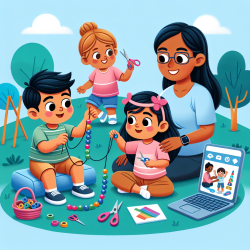Introduction
The COVID-19 pandemic has significantly transformed how mental health services are delivered, with telehealth becoming a vital tool for reaching vulnerable populations. One such innovative intervention is the Building Resilience and Attachment in Vulnerable Adolescents (BRAVA) program, designed to address suicidal ideation in adolescents and strengthen family connections. The recent research article, "Building Resilience and Attachment in Vulnerable Adolescents: The Feasibility of a Virtually Delivered Group Intervention for Adolescents with Suicidal Ideation and Their Caregivers," offers insights into the effectiveness of virtual adaptations of this program.
Understanding BRAVA's Virtual Adaptation
BRAVA is a group intervention that integrates elements of dialectical behavioral therapy (DBT), cognitive behavioral therapy (CBT), and attachment-based family therapy. The program aims to reduce suicidal ideation (SI) and enhance family dynamics. The study conducted by Sheridan et al. (2024) explored the feasibility and acceptability of delivering BRAVA virtually, adapting its modules for online sessions.
Key Findings
- High Satisfaction Rates: The study reported high satisfaction rates among both adolescents and caregivers. While 83.4% of youth and 66.7% of caregivers found the virtual format effective, all caregivers expressed willingness to participate in future virtual sessions.
- Significant Reduction in SI: Adolescents showed a significant decrease in SI post-treatment, with scores dropping from an average of 50.7 to 29.7.
- Engagement and Retention: The program maintained a 100% retention rate, highlighting the potential of virtual interventions in maintaining participant engagement.
Practical Implications for Practitioners
For practitioners, the study offers valuable insights into implementing virtual group interventions effectively. Here are some practical takeaways:
- Leverage Technology: Utilize secure platforms like Zoom to facilitate group sessions, ensuring all participants have access to necessary technology and support.
- Enhance Engagement: Incorporate interactive elements such as role-playing and videos to maintain participant interest and foster a sense of community.
- Address Safety Concerns: Implement robust safety protocols, including emergency contact lists and real-time risk assessments, to manage SI in a virtual setting.
- Gather Feedback: Regularly collect participant feedback to refine and improve program delivery, ensuring it meets the needs of both adolescents and caregivers.
Encouraging Further Research
The promising results of the virtual BRAVA program underscore the need for further research into telehealth interventions for mental health. Practitioners are encouraged to explore the following areas:
- Randomized Controlled Trials: Conduct larger-scale studies to validate the effectiveness of virtual interventions and compare them with traditional in-person methods.
- Longitudinal Studies: Investigate the long-term impact of virtual group therapy on adolescent mental health and family dynamics.
- Diverse Populations: Examine the feasibility of virtual interventions across different demographic groups to ensure inclusivity and accessibility.
Conclusion
The virtual adaptation of the BRAVA program demonstrates the potential of telehealth in delivering effective mental health interventions for adolescents with suicidal ideation. By embracing technology and refining virtual delivery methods, practitioners can enhance their skills and contribute to the growing body of research in this field.
To read the original research paper, please follow this link: Building Resilience and Attachment in Vulnerable Adolescents: The Feasibility of a Virtually Delivered Group Intervention for Adolescents with Suicidal Ideation and Their Caregivers.










